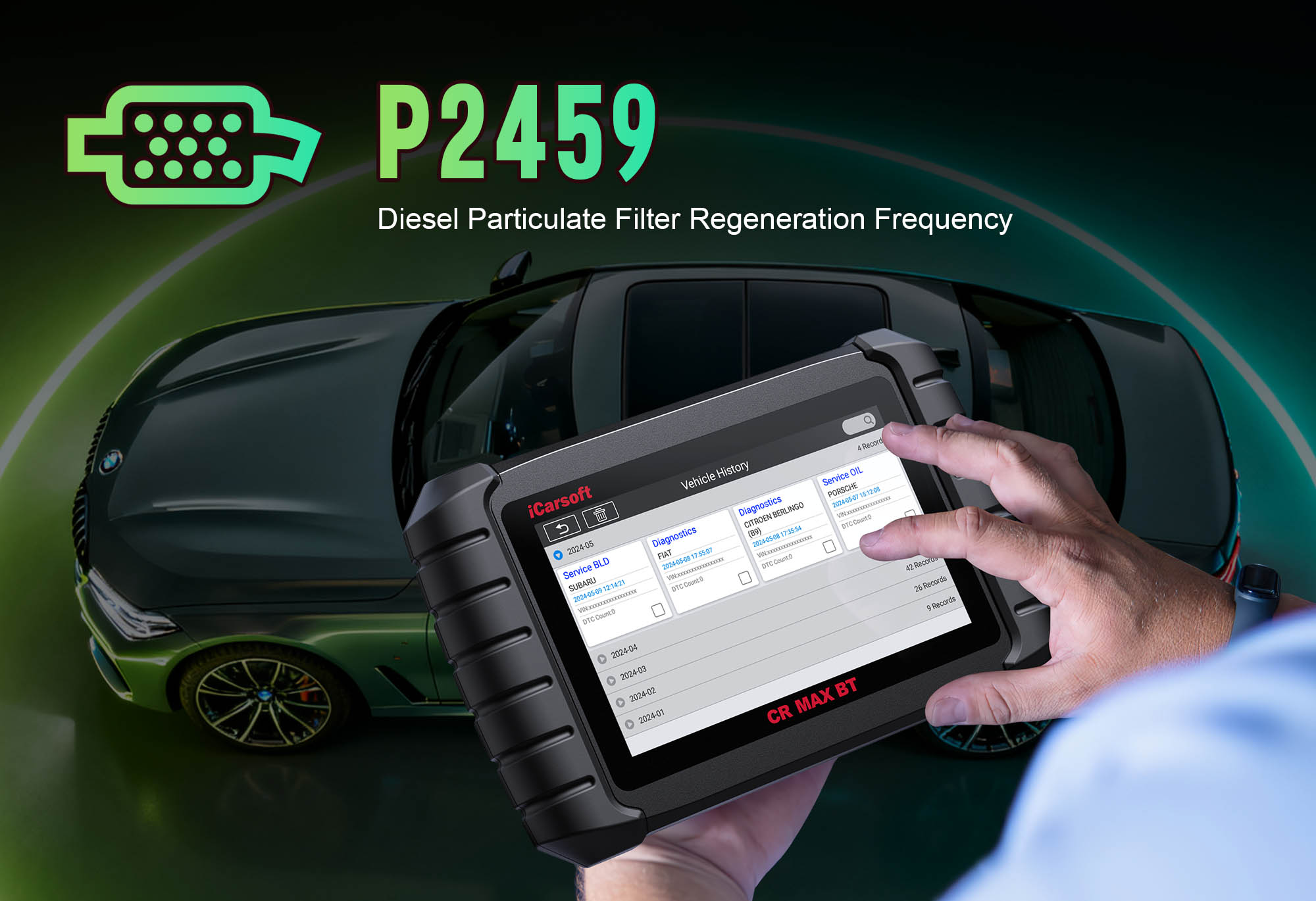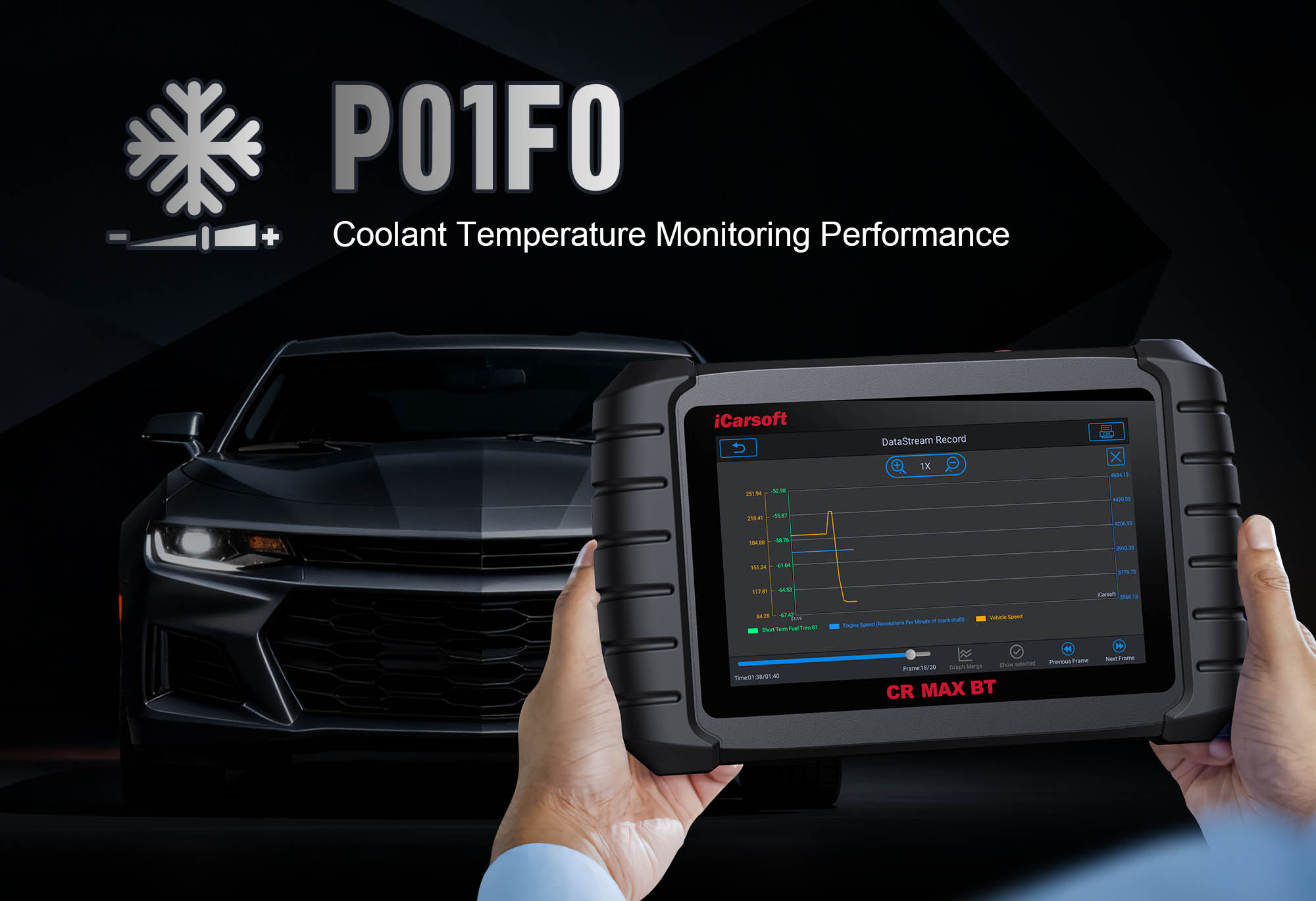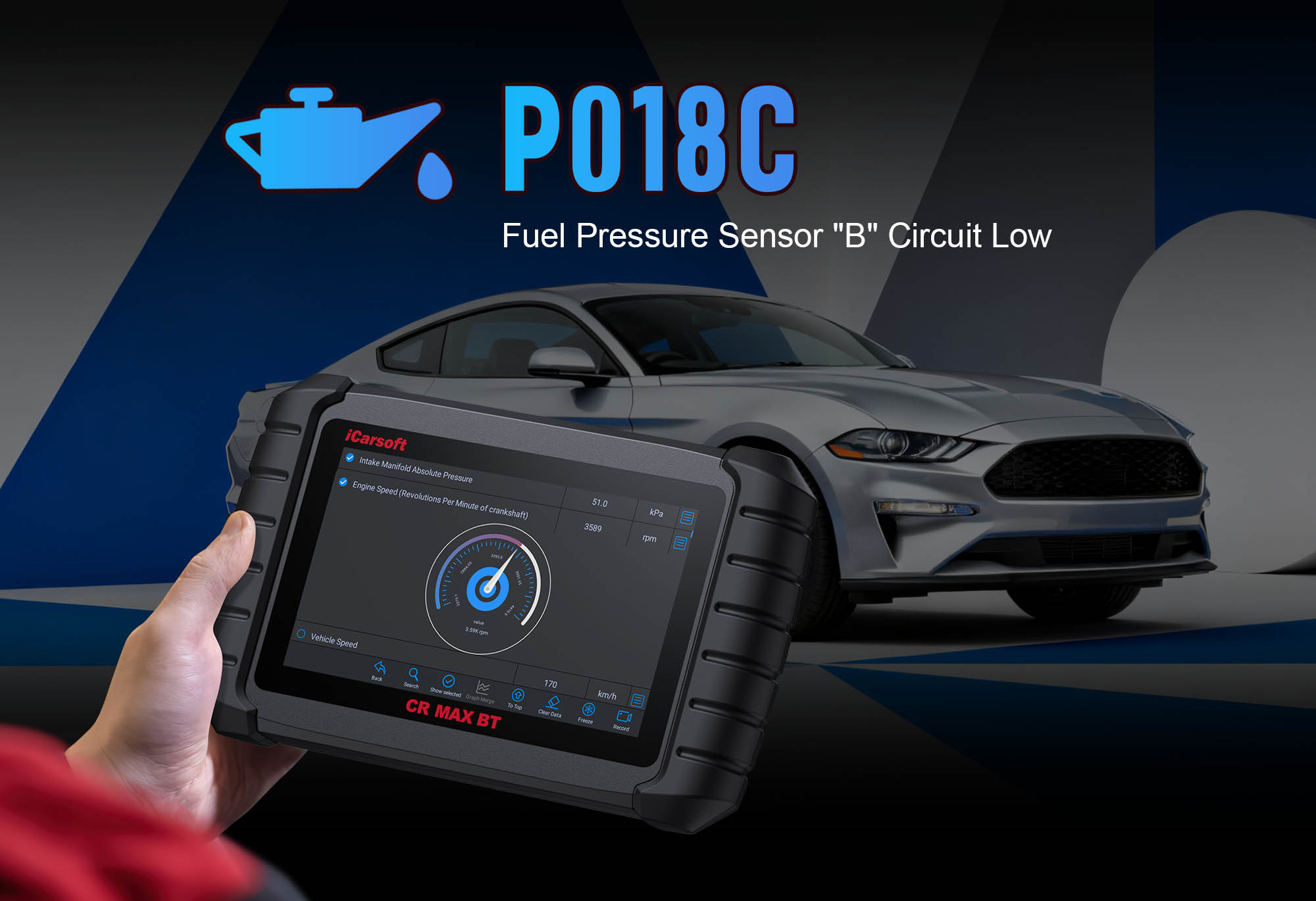Diagnose & Clear P2459 with iCarsoft CR MAX BT
If your diesel vehicle’s check engine light illuminates, you notice reduced power, or a "DPF Fault" warning appears on the dashboard, a diagnostic scan will likely return P2459. This OBD-II code stands for "Diesel Particulate Filter (DPF) Pressure Sensor Circuit High Input"—a fault targeting the DPF pressure sensor, which monitors exhaust backpressure before and after the diesel particulate filter. The Engine Control Module (ECM) uses this data to trigger regeneration (burning off soot) and protect the engine from excessive pressure; when the sensor’s signal exceeds the manufacturer’s maximum voltage range (typically 4.5V–5.0V), the ECM can’t regulate DPF function, leading to soot buildup, reduced fuel efficiency, and potential engine damage.
Basic scanners might only flag a "DPF sensor issue" but can’t test sensor responsiveness, verify exhaust pressure, or isolate electrical vs. mechanical faults—leaving you guessing between a faulty sensor, clogged DPF, or damaged wiring. The iCarsoft CR MAX BT, with its specialized diesel system diagnostics, real-time pressure tracking, and regeneration controls, solves this. Let’s break down how to diagnose and resolve P2459 with precision, using the CR MAX BT’s unique features to restore DPF efficiency and diesel engine performance.
Understanding P2459: Causes & Key Symptoms
The DPF pressure sensor (often a differential sensor) is mounted in the exhaust system, with one port measuring pressure before the DPF and the other after. It converts pressure differences into voltage signals: low soot = low pressure difference = ~0.5V; high soot = high pressure difference = ~4.0V. P2459 triggers when the sensor’s voltage exceeds 4.5V (indicating a false "extreme pressure" reading), often due to a shorted circuit or sensor failure. As the fault persists, symptoms worsen:
Key Symptoms of P2459
-
Check Engine Light (CEL): A steady CEL illuminates, often paired with "DPF Pressure Sensor High Input" or "Regeneration Disabled" messages.
-
Reduced Power: The ECM limits engine output (limp mode) to prevent damage from perceived excessive backpressure.
-
Failed Regeneration: The DPF can’t initiate passive/active regeneration, causing soot to accumulate and eventually block the filter.
-
Increased Fuel Consumption: Inefficient combustion from unburned fuel (due to blocked DPF) drops mileage by 15–20%.
-
Exhaust Odors: A strong diesel smell or black smoke from the tailpipe, indicating incomplete soot burning.
Common Causes of P2459
|
Cause
|
Description
|
|
Faulty DPF Pressure Sensor
|
Internal electrical failure (e.g., shorted resistor) causes the sensor to output voltage above 4.5V, even with normal pressure.
|
|
Damaged Wiring/Circuit
|
Frayed wires, rodent chew marks, or corrosion in the sensor’s power/signal lines create a short, forcing voltage to spike.
|
|
Clogged DPF Pressure Ports
|
Soot, oil, or debris block the sensor’s pressure ports, preventing accurate pressure measurement and causing false high readings.
|
|
Failed DPF Regeneration System
|
A faulty glow plug, EGR valve, or fuel injector disrupts regeneration, leading to excessive soot and real pressure spikes (damages sensor over time).
|
|
ECM Malfunction
|
Rarely, the ECM’s internal circuit for processing DPF sensor data fails, misinterpreting normal voltage as "high input."
|
Why iCarsoft CR MAX BT Excels at Diagnosing P2459
The CR MAX BT outperforms basic tools with features tailored to diesel particulate filter diagnostics—critical for resolving P2459 accurately:
Wireless Bluetooth Connectivity
Test DPF pressure sensor (under vehicle) from 30 feet away—no cords hinder undercarriage access or risk exhaust heat damage.
Live DPF Pressure & Voltage Tracking
Monitors real-time sensor voltage (0–5V) and pressure difference, flagging high input (>4.5V) vs. expected values.
DPF Regeneration Controls
Supports passive/active regeneration initiation (vehicle-specific) to test system function post-repair.
AutoVIN Identify
Automatically detects diesel vehicle specs, DPF thresholds, and exhaust layout—eliminating manual diagram lookup.
Global Diesel Coverage
Works with 58+ makes (Ford Power Stroke, Dodge Cummins, Mercedes BlueTEC) for light/commercial diesel engines—OBD-II/OBD-I compatible.
Sensor Circuit Tests
Built-in multimeter verifies power/ground/signal wire integrity, distinguishing electrical vs. mechanical faults.
DPF Health Reports
Generates pressure trend logs to identify temporary spikes vs. persistent sensor failure.
Step-by-Step: Diagnose P2459 with iCarsoft CR MAX BT
-
Safety First & Initial Visual Inspection
1. Let engine cool 2–3 hours (exhaust/DPF temps exceed 1,000°F during regeneration).
2. Locate DPF pressure sensor via Component Location > Exhaust > DPF System (3–4 pin sensor on exhaust pipe with pressure hoses).
3. Inspect for issues:
- Wiring: Check for frays, burns, or rodent damage along the harness to ECM.
- Sensor Ports/Hoses: Look for cracked hoses, disconnections, or soot-clogged ports.
- DPF Housing: Check for overheating discoloration, warping, or physical damage.
-
Connect Tool & Confirm P2459
Plug CR MAX BT into OBD-II port, select AutoVIN Identify to retrieve specs. Navigate to Engine > Fault Codes > Read Codes to confirm P2459. Tap Code Details for vehicle-specific insights (e.g., "Ford F-250: DPF Sensor Voltage 4.8V, Expected Max 4.5V"). Check related codes (P242F, P2453) and resolve P2459 first.
-
Monitor Live DPF Sensor Data
1. Start engine, idle 5 minutes (no revving).
2. Navigate to Engine > Live Data > DPF System; monitor metrics:
- Sensor Voltage: Normal = 0.5V–4.0V; P2459 shows >4.5V.
- Pressure Difference: Idle = 1–5 psi (spike >15 psi = clogged DPF).
- Regeneration Status: Verify if ECM attempts regeneration.
3. Load Test: Accelerate to 2000 RPM—voltage spike without pressure rise = electrical fault; sharp pressure rise = clogged DPF.
-
Test DPF Sensor Circuit Integrity
1. Turn off engine, disconnect sensor connector.
2. Power Wire Test: Set multimeter to DC Voltage—sensor power pin + chassis ground (ignition ON) = 5V (>5V = shorted wire/ECM fault).
3. Ground Wire Test: Set to Ohms—sensor ground pin + chassis ground = <1 ohm (>5 ohms = clean ground strap).
4. Signal Wire Test: Check continuity between sensor signal pin and ECM (use Wiring Diagram) — 0 ohms = damaged signal wire.
-
Clean or Replace Sensor/DPF Components
- Sensor Port Cleaning: Remove sensor (torque 8–10 ft-lbs), clean ports with brush + diesel cleaner, blow hoses with compressed air.
- Sensor Replacement: Install OEM-equivalent part (e.g., Bosch 0281006053), reconnect connector, torque to specs.
- DPF Cleaning/Replacement: Use Special Functions > DPF > Forced Regeneration for clogs; replace severely blocked DPF and run DPF Replacement Reset.
- Wiring Repairs: Fix frayed wires with heat-shrink, reroute away from exhaust heat.
-
Reset & Clear P2459
1. ECM Reset: Navigate to Special Functions > Engine > Control Unit Reset.
2. Clear Code: Go to Engine > Fault Codes > Clear Codes—confirm P2459 deletion.
3. Regeneration Test: Run forced regeneration via CR MAX BT to verify normal sensor voltage (<4.5V) during process.
-
Validate the Repair
1. Post-Repair Check: Idle/accelerate to confirm sensor voltage stays 0.5V–4.0V.
2. Test Drive: Operate 50–60 minutes (including highway speeds) to trigger passive regeneration.
3. Verify: No CEL/DPF warnings, smooth acceleration, no black smoke.
4. Save Report: Document repairs and post-repair data via History & Report.
Preventing P2459 Recurrence
-
Regular DPF Checks: Use Service Reminder to test pressure sensor voltage every 20,000 miles—catch early spikes.
-
Regeneration Maintenance: Perform forced regeneration every 60,000 miles (or soot load >80%) via CR MAX BT.
-
Sensor Protection: Inspect wiring every 10,000 miles; use heat-resistant loom near exhaust components.
-
Lifetime Free Updates: Use One-Key Upgrade to add advanced DPF diagnostic features.
Conclusion
P2459’s DPF pressure sensor high input isn’t just a warning—it risks costly DPF replacement and diesel engine damage. The iCarsoft CR MAX BT simplifies diagnosis with wireless convenience, live pressure tracking, and regeneration controls, ensuring you address the root cause (whether a faulty sensor, clogged DPF, or wiring issue) instead of guessing.
With its global diesel coverage, 40+ service functions, and lifetime updates, the CR MAX BT is more than a P2459 fix—it’s a long-term investment in keeping your diesel vehicle’s exhaust system efficient. Restore power, reduce fuel use, and extend DPF life—all with one professional-grade diagnostic tool.





